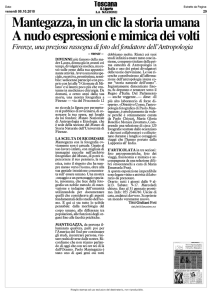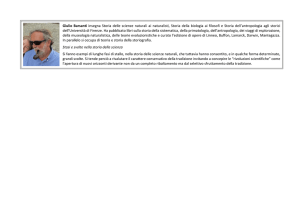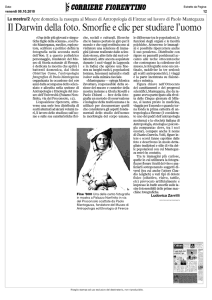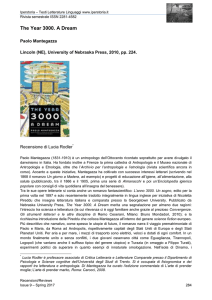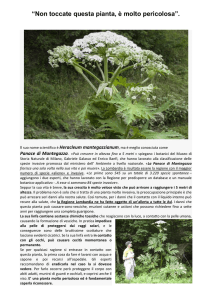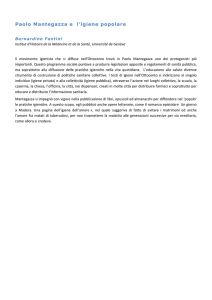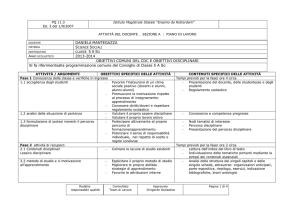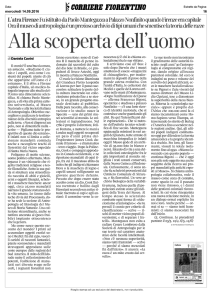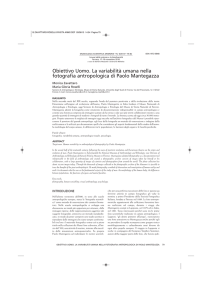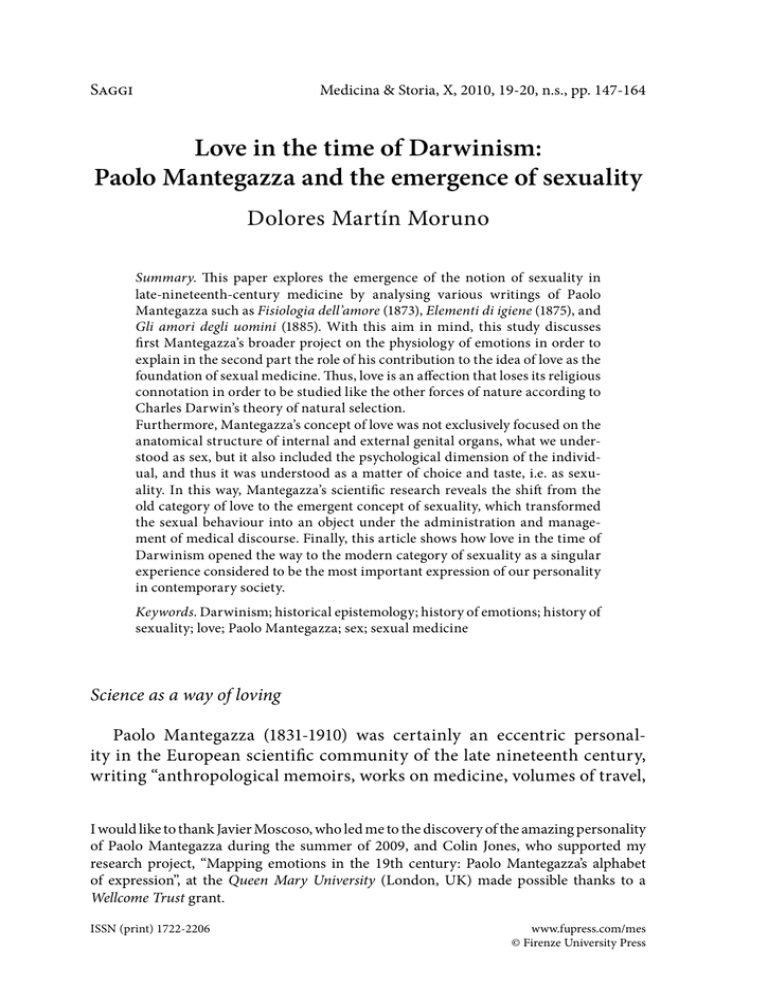
Saggi
Medicina & Storia, X, 2010, 19-20, n.s., pp. 147-164
Love in the time of Darwinism:
Paolo Mantegazza and the emergence of sexuality
Dolores Martín Moruno
Summary. This paper explores the emergence of the notion of sexuality in
late-nineteenth-century medicine by analysing various writings of Paolo
Mantegazza such as Fisiologia dell’amore (1873), Elementi di igiene (1875), and
Gli amori degli uomini (1885). With this aim in mind, this study discusses
first Mantegazza’s broader project on the physiology of emotions in order to
explain in the second part the role of his contribution to the idea of love as the
foundation of sexual medicine. Thus, love is an affection that loses its religious
connotation in order to be studied like the other forces of nature according to
Charles Darwin’s theory of natural selection.
Furthermore, Mantegazza’s concept of love was not exclusively focused on the
anatomical structure of internal and external genital organs, what we understood as sex, but it also included the psychological dimension of the individual, and thus it was understood as a matter of choice and taste, i.e. as sexuality. In this way, Mantegazza’s scientific research reveals the shift from the
old category of love to the emergent concept of sexuality, which transformed
the sexual behaviour into an object under the administration and management of medical discourse. Finally, this article shows how love in the time of
Darwinism opened the way to the modern category of sexuality as a singular
experience considered to be the most important expression of our personality
in contemporary society.
Keywords. Darwinism; historical epistemology; history of emotions; history of
sexuality; love; Paolo Mantegazza; sex; sexual medicine
Science as a way of loving
Paolo Mantegazza (1831-1910) was certainly an eccentric personality in the European scientific community of the late nineteenth century,
writing “anthropological memoirs, works on medicine, volumes of travel,
I would like to thank Javier Moscoso, who led me to the discovery of the amazing personality
of Paolo Mantegazza during the summer of 2009, and Colin Jones, who supported my
research project, “Mapping emotions in the 19th century: Paolo Mantegazza’s alphabet
of expression”, at the Queen Mary University (London, UK) made possible thanks to a
Wellcome Trust grant.
issn (print) 1722-2206
ISSN (online) xxxx-xxxx
www.fupress.com/mes
© Firenze University Press
148 Dolores Martín Moruno
monographs upon special races, biographical studies, romances” and
even science fiction books such as L’anno 30001. As the historian Giovanni
Landucci has observed, Mantegazza was “neither a scientist, nor a literary man”, but rather “a polygamist of many intellectual love affairs” who
embraced knowledge of all kinds2. From science to poetry, his colourful
style of writing, full of metaphors and aphorisms, testifies to what extent
he was a passionate man, a sort of romantic, who claimed to explore the
emotional life of human beings beyond the limits established by the sciences at this time.
Mantegazza was trained as a physician at the Universities of Pisa, Milan,
and Pavia; he would also become one of the first European anthropologists,
and he would occupy the first chair of anthropology in the Faculty of Arts of
the University of Florence, founding the Italian Museum of Anthropology
and Ethnology in 1869 and the journal “Archivio per l’Antropologia e
l’Etnologia”. Before he received recognition as anthropologist, he had
already travelled from South America to India, gaining fame for his contribution to the study of the coca plant, Sulle virtù igieniche e medicinali
della coca e sugli alimenti nervosi in generale (1858), a foundational work in
the emerging field of psychopharmacology3. As it is well known, he would
also embark on a political career as deputy in Monza (1865-1876) and afterwards as senator in the Italian Parliament, at which time he argued for the
necessity of consolidating a new secular state based on the popularization
of science and, in particular, on the social ideology of Darwinism4.
Although it is difficult to classify Mantegazza’s versatile personality
because he seems to have been involved in various – and even contradictory
– subjects of study, he showed a common interest in understanding emotions as natural forces that explained not only human existence, but also
the whole animal realm. Indeed, Mantegazza’s whole work was oriented by
Starr, 1893, p. 550.
Giovanni Landucci, 1977, p. 112. I transcribe the Italian original in order to give further
information to the reader: “Non fu né une grande scienziato, né un grande letterato, ma
fu l’uno e altro e poligamo di molti amori intellettuali abbracciò gran parte del mondo del
pensiero e del sentimento”. 3 See also “On the hygienic and medicinal properties of coca and on nervine nourishment
in general” (1858) and Samorini, 1995, pp. 14-20 to understand how Mantegazza’s
interest in psychopharmacology began when he practised as a doctor in South America
and discovered the medical properties of the coca leaf. This report would inspire Albert
Niemann’s chemical isolation of the alkaloid of the coca plant, cocaine, and furthermore,
Sigmund Freud’s famous paper Über Coca (1884).
4 Pancaldi, 1991, p. 15.
1 2 Love in the time of Darwinism 149
this revolutionary belief and, thereby, he understood human behaviour as
being not only related to the abstract ability of thinking but also to the most
basic affections, sensations or emotions, such as love, hate, and pleasure5.
Furthermore, Mantegazza was completely convinced that it was not
possible to conduct scientific research without passion, because for him,
to study science, and in particular to practice medicine, was just another
way of demonstrating love. In this case, his passion was aimed at mitigating suffering and improving the happiness of mankind. Moreover, if there
is a feature that could describe this passionate man, it was undoubtedly his
defence of love as “the most powerful but least studied of human emotions”
that should also be considered as “the first force of human progress” in
Western societies6.
For all these reasons, I have chosen to discuss in this article what constitutes the most relevant and controversial part of Mantegazza’s research,
which is aimed at explaining the mechanism of love in a scientific way,
defying the traditional conception supported by the Catholic Church on
sexual matters. As I shall show throughout this article, Mantegazza’s work
on love marked the shift from love to sexuality, i.e. the moment in which
the old ars amatoria became a scientia sexualis. Thus, Mantegazza’s work
showed a new style of reasoning in late-nineteenth-century medicine that
was not focused on describing the anatomical structure of the internal and
external genital organs, but rather the psychology of the individual, “his
impulses, tastes, aptitudes, and satisfactions”7.
Following Michel Foucault and Arnold I. Davidson’s works, I will interpret Mantegazza’s concept of love as the scientific roots of the concept of
sexuality, a notion that has become accepted as the best way to represent
our modern identity concerning sexual relations8. With this aim in mind,
I will briefly introduce the main points of Mantegazza’s whole project on
the physiology of emotions in order to explain in the second part of this
article the role of his contribution on love as the foundation of modern
sexual medicine.
Recent academic works have shown an interest for studying emotions as a new kind
of paradigm to understand the humanness of our world, rather than a model based on
rationality, technology, or economic relations. I have analysed Mantegazza’s scientific
research according to this approach suggested amongst others by Bourke (2005), Dixon
(2003), Nussbaum, (2001) Oatley, (2004) and Reddy (2001).
6 Mantegazza, 2007, p. 75.
7 Davidson, 2004, p. 35.
8 See Foucault, 1984, p. 338
5 150 Dolores Martín Moruno
Paolo Mantegazza’s “cosmogonia sensitiva e affettiva”
We know that Paolo Mantegazza was interested in studying emotions
from his early life. When he was a twenty-two-year-old student at the
University of Pavia, he began to write Fisiologia del piacere (1854), a very successful book that would benefit from international acceptation and would
be published in more than twenty editions in various languages. Although
Mantegazza’s idea of physiology at that time was primarily literary and
aesthetic, he already had a clear insight into the project that he wanted to
achieve: a physiological study of moral man, which could explain the whole
emotional life of human beings based on four vital principles: pleasure, pain,
love and hate. More than thirty years later, when he was a mature scientist,
he would give this project the name of “a cosmogonia sensitiva e affettiva”,
a study that had been developed by analysing the emergence of these basic
phenomena – love, hate, pleasure, and pain – in man and animals.
In tre volumi, che non sono morti ancora ho tentato di tracciare i poli
entro i quali si muove il mondo umano; ma a completare questa cosmogonia
sensitiva e affettiva mi rimane ancora a studiare l’odio che sta all’amore come
il dolore sta al piacere9.
Following this general idea, Mantegazza subsequently published
Fisiologia del piacere (1854), Fisiologia dell’amore (1873), Fisiologia del dolore
(1880), Fisiologia dell’odio (1889), and even an essay on the physiology of
beauty in Epicuro: saggio di una fisiologia del bello (1891). Throughout this
vast project, emotions were defined as natural traits derived from the past,
which were the result of the evolution of man and animals according to
Charles Darwin’s theory of natural selection. Like the English naturalist,
Mantegazza considered the expression of emotions as a type of self-protection and also as a way of communicating certain states of mind by means of
particular facial muscles.
In contrast to the old language of passions and affections characterising the theological conception, Mantegazza understood pleasure,
pain, hate, and love not just as feelings belonging to the soul, but rather
as phenomena having a psychological dimension, which was the result
of a more complex physiological process that takes place in the human
body10. Furthermore, this Italian scientist would maintain a plentiful cor9 Mantegazza, 1896, p. 3.
Dixon, 2003.
10 Love in the time of Darwinism 151
respondence with Darwin from 1868 until 1875 in which he expressed his
enthusiastic support for the theory of natural selection and, in particular,
for the notion of variation, which was described as a sublime monument
to human intelligence. We can understand to what extent Mantegazza
would recognise Darwinism as a kind of secularised religion in the following letter written in 1868:
At least as a shade I want to enter the sanctuary in which you are reforming science, where you are opening up unlimited horizons for meditation and
for the philosophy of the future11.
Like the whole generation of late-nineteenth-century Italian intellectuals and scientists, Mantegazza believed that Darwinism should be regarded
as a powerful ideology, which could help to establish the independence of
the state from the Catholic Church and, thereby, to accelerate the process
of secularisation of the recently created Italian state by accelerating social
and economical progress. Other followers of evolutionism such as the physician Carlo Matteucci (1811-1868), who was for a while minister of education, and Enrico Ferri (1856-1929), a disciple of the popular criminologist
Cesare Lombroso (1835-1909), who was also a colleague of Mantegazza,
supported these theses and used them to guide the country in its first
steps as an independent nation. As G. Pancaldi has pointed out, although
Darwin’s and Spencer’s books were not best sellers in Italy, expressions such
as “the struggle for life” became current in the intellectually sophisticated
late-nineteenth-century Italian political panorama, and were used to justify
very different political positions in the Italian Parliament12.
The first stage in Mantegazza’s sensitive and affective cosmogony was the
analysis of pleasure as a sensation that arises from a particular modification
of a specific part of the central nervous system, which he called “la polpa
nervosa sensibile”13. Mantegazza examined the whole spectrum of hedonistic experiences in relation to senses such as sight, to feelings like self-esteem
and, finally, to the intellect, when ascetic pleasures – like the pleasure of
memory – are examined. As he observed in Fisiologia del piacere, pleasure
should be understood as the reason that explains why humans and animals
love existence and preserve their lives.
Mantegazza, 1868, p. 16. Mantegazza’s letters sent to Darwin could be read in Burkhardt
et al., 2008, vol. 16, parts 1 and 2.
12 Pancaldi, 1991, p. 152.
13 Mantegazza, 1992, p. 402.
11 152 Dolores Martín Moruno
In generale il piacere accompagna la soddisfazione di un bisogno. Quando
esso non ha un fine diretto, contribuisce ad abbellire la vita e quindi concorre
al fine supremo di far amare l’esistenza e difenderla dalle potenze nemiche14.
Mantegazza would continue to explore the meaning of pleasure in his
Quadri della natura umana. Feste e ebrezza (1871), which he conceived as a
classification of stimulants, or what he called alimenti nervosi, understanding them as instruments to obtain knowledge about the mind as a part of
the human body. As he explained, this work was aimed at establishing the
different states of inebriation by means of ingesting “nervine foods” as a
continuation of the natural history of pleasure. For Mantegazza, the use
of stimulants or drugs made life happier because under their influence all
troubles were mitigated and could be forgotten15.
Linked with this research on pleasure, Mantegazza would also study
pain as a sensation produced by a change in our sensibility, differing only
from the first in the intensity of the sensation experienced. As he wrote
in his Fisiologia del dolore (1880), pleasure and pain were transmitted by
the same part of the central nervous system and therefore, both phenomena should be placed in a continuum only having a difference of degree.
To demonstrate his thesis, Mantegazza compiled detailed experimental
research on the influence of this phenomenon in human and animal bodies
in relation to animal warmth, heart movement, the mechanism of breathing, digestion, and nutrition. He concluded both phenomena are not opposite principles and seemed most likely to be placed in a continuum. In this
respect, he cited the example of the melancholy in which the subject would
experience alternating moments of pleasure and pain.
La pratica quotidiana della vita ci persuade poi, che nessun abisso separa
questi due poli, ma che per gradazioni infinitamente piccole si può passare
dall’uno all’altro. Anzi talvolta la nostra conscienza rimane incerta, quale dei
due battesimi debba dare alla sensazione16.
Mantegazza not only made a study of pain based on an analysis of chemical and physical processes involved in its production, but he also developed a semiotic interpretation of bodily and facial expressions of emotions as Duchenne de Boulogne had already proposed in Le Mécanisme
de la Physionomie Humaine (1862). In his Atlante della espressione del
Mantegazza, 1992, pp. 10-11.
Mantegazza, 1871, pp. 175-178.
16 Mantegazza, 1880, p. 14.
14 15 Love in the time of Darwinism 153
dolore (1876), Mantegazza presented the first photographic study applied to
anthropology by showing the different expressions of pain in different races
in order to illustrate his experimental work. As he explained:
Questo Atlante è destinato a illustrare i miei studi sperimentali sull’espressione del dolore che saranno publicati nell’Archivio per l’Antropologia e la Etnologia e nella Fisiologia del dolore17.
Following the impact of Duchenne de Boulogne’s approach, Mantegazza
was convinced that photography was the most objective method of obtaining useful information about “man’s knowledge from a naturalistic point
of view”, bearing in mind his ecological surroundings18. Thus, photography was introduced as a scientific tool that reproduced reality and, thereby,
demonstrated cultural diversity by giving meaning to the expression of different emotions. The main focus of this research was to provide a guide to
facial expressions resulting from the infliction of painful stimuli on various
subjects, including Mantegazza himself. According to this practice, Carlo
Brogi, who was Mantegazza’s photographer, portrayed individuals suffering
different kinds of pain related to the senses, such as olfactory pain after the
ingestion of ammonium sulphate, and to the intellect, when for example the
act of reflection is revealed by painful expressions.
Mantegazza would also publish a most comprehensive and vast work
on physiognomy, which “was the result of years of observation and study
of human expressions”19. Deeply inspired by Darwin’s The Expression of
Emotions in Man and Animals (1872), he wrote Fisionomia e mimica (1881), a
book that he conceived of as a page of psychology, which was aimed at establishing a kind of alphabet to interpret the expression of emotions. According
to this basis, Mantegazza studied the features of the human face considering
the morphology of the individual, such the size and length of the face and
skull and their proportions, the forehead and the eyes in relationship to the
successive epochs, and the accidents of life. Although Mantegazza recognized the strong influence of Darwin in his research, he claimed to go one
step further than Darwin in elaborating a study of emotions, which included
the new science of anthropology that focuses on the cultural, historical, and
gender aspects involved in the expression of the emotions20.
Mantegazza, 1876, p. 1.
Zavattaro, Roselli, Chiozi, 2010, p. 6.
19 Piccardi, 1998, p. 92.
20 In Fisionomia e mimica Paolo Mantegazza explained how expressions emerged in
progressive stages as 1) expressions of the senses, 2) expressions of the passions (feelings
17 18 154 Dolores Martín Moruno
Besides his contribution to the study of physiognomy, Mantegazza
also published a medical work devoted to shedding light on the nature
of hate. Thus, in his Fisiologia dell’odio (1889), he analysed various collective and individual mechanisms of violence in comparison to different cultures and epochs from ancient Greece to contemporary Europe.
From this point of view, hate should be studied through its degree and
its different expressions such as rage, revenge, cruelty, resentment,
and even war. Although hate had been commonly considered since
time immemorial as a vice or a crime from a theological point of view,
Mantegazza argued for the role of this emotion in the understanding
of human and animal behaviour. However, he envisaged the sublimation of hate in the future of mankind as a result of the civilisation process, which was based on values such as education and justice. As he
explained in the following paragraph:
Eppure l’egoismo, l’amor propio e il concetto etico hanno tale influenza
[…] a falsare le osservazioni psicologiche, che noi abbiamo fatto dell’odio un
sinonimo di vizio o di delitto e non confessiamo quasi mai di provare quest’emozione affetiva, che è pure una delle più naturali delle più necessarie della
natura, non solo umana, ma animale21.
Finally, amongst all these different emotional phenomena, which were
understood as a kind of universal feature in human and animal behaviour, Mantegazza emphasized the role of love in his sensitive and affective cosmogony as “the strongest, the richest and most human of the
passions”22 . As we will see in the second part of this presentation, love
became the central energy in Mantegazza’s physiology of emotions laying the biological foundation of life by means of the alternating dynamics of birth and death. According to Charles Darwin’s theory of sexual
selection, Mantegazza would establish a science of love based on a comparative analysis of the sexual relations of mankind, animals, and flowers, which included the notion of beauty as the basis of all desire, and
that of pleasure as the main objective of the sexual union that was not
solely oriented to procreation.
in relation with one’s self and relative to the others) and 3) expressions of the intellect such
as meditation or attention.
21 Mantegazza, 1896, p. 5.
22 Mantegazza, 2007, p. 94.
Love in the time of Darwinism 155
The Florentine’s love trilogy
Mantegazza explored the physiological, psychological, and cultural
aspects of love in his Florentine Love Trilogy, a project named as such
because it had been written when he was professor of anthropology at
the Istituto di Studi Superiori di Firenze. This work focused on explaining the many aspects of love in relation to the individual, various cultural groups, and social institutions. This trilogy, which was comprised of
Fisiologia dell’amore (1873), Elementi di igiene (1875), and Gli amori degli
uomini. Saggio di una etnologia dell’amore (1885), was devoted to illuminating love from its origins as the physical attraction emerging between
two bodies to different cultural manifestations, such as courtship, marriage, or even prostitution. Broadly speaking, this ambitious project was
aimed at studying love as an element of health not only considering the
individual but also the successive generations, which appears in different
forms among the various races and epochs. As Mantegazza explained in
his introduction:
L’Amore mi è sempre sembrato circondato […] e difeso da una triplice selva di pregiudizi, di misteri e di ipocrisie, gli uomini civili lo conoscono troppo
spesso per via del furto o della vergogna […] Studiarlo come un fenomeno
della vita e come forza gigantesca, che si piega in mille maniere nelle diverse
razze e nei diversi tempi; studiarlo come elemento di salute dell’individuo e
delle generazioni, mi è sembrato impresa grande; mi è parso che fosse onorevole anche solo il tentarla23.
The starting point in Mantegazza’s trilogy of love was his Fisiologia
dell’amore, which was undoubtedly his most popular work. As it is well
known, this book was related to Sigmund Freud’s case of Dora, the patient
who developed her sexual fantasies whilst she was reading Mantegazza’s
book 24. Although The Physiology of Love could seem at first a dry professional treatise on anatomy or physiology, it was rather a philosophical essay,
which includes metaphysical and even moral reflections showing how love
appears in our modern-day society and how it should be in a better one.
In this work, love was not exactly defined as an emotion, something that
is internally felt, but rather as an affection, i.e. the expression of an internal
Mantegazza, 2003, p. VII.
See Bernheimer, Kahane, 1990, p. 257. Freud also mentioned Mantegazza’s Physiology
of Love in relation to the case of his patient Dora, who recognised having strange sexual
ideas in reading this work.
23 24 156 Dolores Martín Moruno
feeling that flows amongst people and requires some effort, in the same way
as taking care of somebody does. Accordingly, love arises metaphorically as
a mysterious creative chemistry between two unequal atoms. This attraction or sympathy, which we usually call ‘feeling’, governs the energy accumulated in the nerve centres that are subsequently transformed by means
of the muscles into different bodily and facial expressions that reveal this
affection in the physiognomy of the individual. In this way, every sense,
every emotion, and every thought of the mind are instruments of love
whose purpose is the conquest of the loved one.
In light of these conceptions, Mantegazza studied the body as a kind of
laboratory in which a physiological process took place, connecting love with
senses, feelings, and the intellect. Keeping in mind this schema inspired
by Plato’s division of the soul, Mantegazza examined love first in relation
to touch, which is aimed at the physical possession of the loved one as is
shown through a kiss, to sight, which is the faculty that elevates love into
the region of the ideal, to smell, which is linked to the sexual emanations as
excitants, and to hearing, which reveals the sexual character of voices. It is
curious to note that for Mantegazza taste “takes no part in the pleasures of
love save in exceptional cases and which can without scruple be dispatched
to the clinic of pathological psychology”25.
Furthermore, love is analysed concerning not only the senses, but also
feelings such as jealousy which are interpreted as pathological behaviour
patterns particularly notorious amongst Sicilians and Spaniards due to ethnological influences. Finally, Mantegazza described the influence of love
on the intellect and how it was exerted, based on the psychic evolution of
the two sexes, i.e. considering the anatomical difference between men and
women. Although Mantegazza emphasised the role of women in sexual
selection, he would continue to assume that females were less intelligent
than males and he justified it by referring to different biological functions
such as maternity.
In this respect, Mantegazza can be considered a sexist and even a paternalist when he claimed that women were dominated by what he called “the
ideology of sacrifice” in other works such as Fisiologia della donna (1893)
or L’arte di prender moglie (1891) and L’arte di prender marito (1894)26.
Furthermore, he considered women’s emancipation and the emergent
Italian feminist movement as a rebellion more against the nature that created them as women, than against male civilisation. Although Mantegazza
25 26 Mantegazza, 2007, p. 190.
Mantegazza, 2007, p. 22.
Love in the time of Darwinism 157
was deeply influenced by the personality of his mother, Laura Solera (18131873), a famous patriot who fought during the Italian unification in the
same faction as the leader Giuseppe Garibaldi (1807-1882), he echoed the
longstanding patriarchal tradition when he associated women with values
such as sensibility and men with their natural aggressiveness27.
For Mantegazza, the first assumption in the religion of love was that
women were less capable of being devoted to the abstract ability of thinking
because they were by definition more attached to the realm of the lowest
passions, an argument that was directly refuted at that time by the British
feminist Margaret Sackville28.
Sembra che la debolezza del carattere, l’emotività, la minore efficacia intellettuale della donna, non fossero qualità necessarie, insite, trascendentali,
invariabili del suo spirito, ed essenzialmente collegate col sesso, ma il risultato
delle vicende della sua esistenza e rimontavano con molta probabilità alla fisiologia femminile29.
Mantegazza would also study the phenomenon of love from a very different point of view, i.e. considering sexual life as an important element in
preserving health and combating disease. Thus, in his Elementi di igiene, a
work that he conceived of as an essay on the art of loving, he discussed some
topics such as the role of male sperm and of female menstruation, human
masturbation, the use of aphrodisiacs to treat impotence, and sterility in
men and infertility in women. In that light, we can appreciate Mantegazza’s
efforts to provide sexual education to men, women, and children and, in
particular, those belonging to the working class, who depended on the
charity of religious orders.
Indeed, Mantegazza dedicated this work on the hygiene of love to Luigi
Billi, the director of the new maternity hospital in Florence, because he
was completely aware of the necessity of popularizing basic information
on sexual matters in the new Italian state. Furthermore, during his political career he repeatedly demanded social reforms aimed at granting the
poor access to the health care system. In fact, his controversial opinions on
Laura Solera was an Italian patriot of the Risorgimento, who participated actively in
Italian unification. She also made considerable efforts in order to emancipate Italian
women, founding in 1850 the first kindergarten for young children coming from poor
families, and, in 1870, the first vocational training school for women. For further reading,
consult Paolo Mantegazza, 1886.
28 See Sackville, 1900, pp. 88-89.
29 Mantegazza, 2003, p. 89.
27 158 Dolores Martín Moruno
sexual hygiene as well as his defence of the right of divorce and the legalisation of prostitution gave him the surname of l’erotico senatore, a pejorative
label coined by Giovanni Papini in order to discredit Mantegazza’s political
ideas30. As he observed in the following paragraph, his project on sexual
hygiene needed to be accompanied by political and legal reforms.
Vorrei in questo mio libro dimostrare che l’igiene non puo esser chiusa
in mezza dozzina di aforismi volgari ed agoisti, ma che invoce è tutta una
scienza sociale che, appena nata, aspetta luce e forza dalla fisiologia e stendo
la mano all’economia politica a alla legislazione31.
Finally, Gli amori degli uomini should be considered as the most revolutionary book of Mantegazza’s trilogy for having developed an anthropological study of love that collected all the curiosa of sexual life and customs
of mankind – including ancient and modern, ‘savage’ and ‘civilized’ – such
as, for example, diverse rituals related to the mutilation of sexual organs32.
As he explained, his purpose was to contribute to a sexual history of mankind from puberty to menopause based on anthropological data in order
to remove prejudice, mystery, and hypocrisy in the European mentality
and, in particular, in Italian society where the Catholic Church still had too
much influence in relation to sexual matters.
Nonetheless, Mantegazza was not strictly a radical, but rather a moderate
thinker who sometimes supported very reactionary points of view in relation to subjects such as homosexuality, which he considered a pathological
behaviour, sodomy, and masturbation that were also described as perversions, i.e. “sexual desires or practices that are in some sense unnatural”33.
Like Richard von Kraft-Ebing, who had classified the rarest sexual perversions amongst civilized Europeans, Mantegazza understood masturbation
as an aberration of nature and even as a disease that showed the inferiority
of a culture.
La masturbazione […] è una malattia fisica e morale atta a segnare un
marchio di abiezione e di decadenza in un popolo e in una razza. Essa avvilisce l’uomo nell’età della poesia e degli ardimenti e sostituisce alle battaglie
violente e gloriose dell’amore le lascivie segrete e facili della mano o d’ordiFor further information, Mantegazza’s biography can be consulted in Boni, 2002.
Mantegazza, 1864, p. 8.
32 A separate edition of this part belonging to The Sexual Relations of Mankind has been
published by Kessinger Publishing as The Mutiliation of the Sexual Organs.
33 Nagel, 1998, p. 326.
30 31 Love in the time of Darwinism 159
gni più vili ancora: di qui la viltà, ipocrisia, abbrutimento, prostituzione del
carattere34.
Mantegazza concluded his ethnography of love by presenting an anthropological theory of sex, in which he emphasized how passion was more a matter of knowledge than of degree and, thereby, that our Western Civilisation
should dispense with the sexual taboos and imitate other cultures that had
given instruction in the art of love from time immemorial, such as the
Hindus. Thus, Mantegazza’s science on the sexual relations of mankind was
aimed at providing basic information on this subject in order to better enjoy
sexual pleasure. His research also included the sexual pleasure of women,
which was supposed to be more intense than that experienced by men.
In short, Mantegazza’s aim was to explore love, like all the other forces
of nature, as an affection that in the age of Darwinism was defined within a
most comprehensive scientific framework in order to be controlled and measured in late-nineteenth-century medical discourse35. Indeed, Mantegazza
considered his science on the sexual relations of mankind to be intimately
linked to a political project on sexual hygiene, which was focused on dangerous eugenic measures oriented “to eliminate step by step the bad and ugly”
through selection, “so that our race will progressively and slowly improve”36.
Besides these negative implications, Darwinism was also considered in
late-nineteenth-century Italian society as a way of reinforcing the secularisation of the recently created Italian state, thus eliminating, furthermore,
the prejudices and superstitions imposed for centuries around sexual relations37. The period was perceived by Italian intellectuals as being devoted to
the foundation of the new country through the revaluation of national and
cultural identity in modern and rational terms. This is why the whole generation of Italian reformers, in which Mantegazza participated, perceived
the popularization of science as a “systematic educational mission that paid
special attention to those branches of science that had a direct impact on
general worldviews”, such as love38.
Finally, we can appreciate how Mantegazza’s main goal was to spread
a new conception of sexual relations based on late-nineteenth-century
European science and, notably, on Charles Darwin’s theory of sexual selecMantegazza, 1886, p. 134.
Foucault, 1984.
36 Sigusch, 2008, p. 221.
37 See also Mantegazza, 1868 and Comoy Fusaro, 2008. 38 Pancaldi, 1991, p.154.
34 35 160 Dolores Martín Moruno
tion. Moreover, this conception of love was interpreted in cultural terms
according to the Victorian ideology as a deity to which men and women
devoted their existence, when religion was replaced by romance as the
focus of daily life. As Eva Illouz has observed, love became the last holy
place in the rise of European Positivism, i.e. “a template for the authentic,
albeit, restrained, expression of their inner self, but it was also a means to
attain spiritual perfection, as was made clear by the consistent association
of romantic discourse with the values and metaphors of religion”39.
As I will conclude in the next section, Mantegazza’s study of love marked
precisely the emergence of a new scientific and cultural understanding of
sexual relations – what we call today ‘sexuality’. Following this approach,
sexuality acquired a radically different meaning in relation to the concept
of sex, because the latter was not strictly oriented to procreation, but rather
to obtaining pleasure in the individual being.
Love in the time of Darwinism
Paolo Mantegazza’s conception of love was deeply inspired by Charles
Darwin’s theory of sexual selection, which was essentially a response to
some objections to the theory of natural selection. One example of this is
the attempt to understand why certain animals belonging to the same species and living in the same environment reveal such remarkable aesthetic
differences amongst them, such as ornaments and weapons. Although these
‘secondary characters’ had apparently no purpose in the struggle for life,
they played an essential role in the struggle between the individuals of one
sex for the possession of the other sex. As Darwin explained in The Descent
of Man and Selection in relation to Sex (1871), sexual selection had played
an important role in the history of the organic world, a struggle which had
been observed generally amongst the males.
It is certain that with almost all animals there is a struggle between the
males for the possession of the female. This fact is so notorious that it would
be superfluous to give instances. Hence the females, supposing that their
mental capacity sufficed for the exertion of a choice, could select one out of
several males. But in numerous cases it appears as if it had been specially arranged that there should be a struggle between many males40.
39 40 Illouz, 1997, p. 29.
Darwin, 1871, vol. 1, p. 259.
Love in the time of Darwinism 161
Nonetheless, Mantegazza did not completely agree with Darwin’s original theory of sexual selection as a mechanism oriented to functionality, i.e.
to the reproduction of the species and whose protagonists were not exclusively male. On the one hand, Mantegazza thought that procreation was not
the real motive for sexual union, but only an undesired effect of the contact
produced by lovers. Unlike Darwin, he understood love not only in relation
to what Michel Foucault called “the experience of flesh”, i.e. sex, but rather
to sexuality, a concept which appears in his writings as the source of sexual
pleasure and, furthermore, the beauty and the joy of the individual being.
On the other hand, Mantegazza emphasized in his physiology of love the
fact that women were not passive agents in sexual intercourse. Although he
had established gender roles in separate cultural spheres, he concluded that
love was a matter of choice for males and females, because both participated
actively in the conquest of the other sex. From this approach, love became a
matter of choice, something that “we would choose for ourselves and those
close to us”41.
In doing so, Mantegazza introduced a revolutionary aspect in the conception of love, which was neither centred on feelings as if they were a kind
of spiritual force, nor on the anatomical structure of internal and external
genital organs, but rather on the physiological process that takes place in
the body. Seen in this light, Mantegazza’s concept of love does not only correspond to what we understand today as sex, but also to sexuality, i.e. the
impulses, tastes, aptitudes, satisfaction, and psychic traits of the individual. Following the main thesis of Davidson’s historical epistemology, it was
only in late-nineteenth-century medical discourse that sexuality emerged
as a singular form of experience, which became “the best way in which
the mind is represented” and which furthermore defined, our identity by
means of our “capability of having sexual feelings”42.
According to this new style of reasoning focused on the psychology of
the individual, we can finally perceive the role of Mantegazza within the scientific movement that gave birth to the science of sexual medicine together
with other relevant personalities such as Kraft Ebing, Henry Havelock, and
the anthropologist Bronislav Malinowski. As Volkmar Sigusch has pointed
out, Mantegazza “founded a new science that had not been given any name
before, and which he defined himself, faute de mieux, ‘this science’ and also
the ‘science of embrace’”43.
Baker, 1998, p. 1.
Davidson, 2004, p. 31. In this respect, Davidson follows Foucault, 1984, pp. 334-335.
43 Sigusch, 2008, p. 218.
41 42 162 Dolores Martín Moruno
I have interpreted throughout this article his project as revealing the
shift from the old religious idea of love to the modern concept of sexuality
in late-nineteenth-century medicine. Indeed, we can finally appreciate this
change through a comparison of the different editions of Paolo Mantegazza’s
works, such as the original Gli amori degli uomini and the English translation, The Sexual Relations of Mankind. Although it was only an apparently innocent change, the new concept of sexual relations showed how the
poetical term of love became a scientific subject that could be examined,
compared, and measured by late-nineteenth-century European physicians.
This was exactly what Mantegazza had tried to achieve in publishing this
trilogy: to modernize the traditional conception of love as the new science
of sexual medicine thanks to the new scientific background provided by
Darwinism. In this way, love became, with the rise of Positivism, synonymous with sexuality, i.e. the culture that looks at and talks about the whole
individual, making an externalisation of the hidden, and the inner essence
of personality.
Bibliography
Baker Robert B., Wininger Kathleen J. and Elliston Frederick A. (eds.), 1998,
Philosophy and Sex, Amherst-New York, Prometheus.
Bernheinmer Charles, Kahane Claire (eds.), 1990, In Doras’ Case: Freud, Hysteria
and Feminism, New York, Columbia University Press.
Burke Peter, 2005, ‘Is there a cultural history of Emotions?’, in P. Gouk, H. Hills
(eds.), Representing emotions. New connections in the histories of art, music and
medicine, Aldershot, Ashgate, pp. 35-49.
Boni Monica, 2002, L’erotico senatore. Vita e studi di Paolo Mantegazza, Genova,
Name, vol. 6.
Burkhardt Frederick, Samantha Evans, Alison M. Pearn (eds.), 2008, Evolution.
Selected letters of Charles Darwin 1860-1870, Cambridge University Press.
Comoy Fusaro Edwige, 2008, ‘Réflexions sur le texte pseudo-littéraire chez Paolo
Mantegazza: Un giorno a Madera. Una pagina dell’igiene d’amore’, Cahiers de
Narratologie, 14, pp. 1-10.
Darwin Charles, 1871, The Descent of Man and Selection in Relation to Sex, London,
John Murray.
—1872, The Expression of the Emotions in Man and Animals, London, John Murray,
vol. 1.
Davidson Arnold I., 2004, The Emergence of Sexuality: Historical Epistemology and
the Formation of Concepts, Harvard, Harvard University Press.
De Boulogne Duchenne, 1862, Mécanisme de la physionomie humaine ou analyse
électro-physiologique de l´expression des passions, Album. Paris, Joules Renouard.
Love in the time of Darwinism 163
Defina Maria Teresa, 2009, L’amore in Paolo Mantegazza, Tesi di Laurea, Università
degli Studi della Calabria.
Dixon Thomas, 2003, From Passion to Emotions: the Creation of a Secular
Psychological Theory, Cambridge, Cambridge University Press.
Foucault Michel, 1984, The History of Sexuality, The Use of Pleasure, 2, London,
Penguin.
Freud Sigmund, 1885, Cocaine Papers, New York, Stonehill Publishing Co.
Haeberle Erwin J., 1997, ‘Sexology: From Italy to Europe and the World’ in C.
Simonelli, F. Petruccelli, V. Vizzari (eds.) Sessualità e terzo millennio, studi e
ricerche in sessuologia clinica, vol. 1, Milano, Franco Angeli, pp. 13-22.
Illouz Eva, 1997, Consuming the Romantic Utopia. Love and the Cultural Contradictions
of Capitalism, Berkely-Los Angeles-London, University of California Press.
Landucci Giovanni, 1977, Darwinismo a Firenze. Tra scienza e ideologia (1860-1900),
Firenze, Olschki.
Mantegazza Paolo, 1864, Elementi d’igiene, Milano, Gaetano Brigola
—1866, La mia mamma, Firenze, G. Barbèra.
—1868, Un Giorno a Madera. Una pagina dell’igiene d’amore, Milano, Fratelli
Rechiedei e presso G. Brigola.
—1871, Quadri della natura umana. Feste ed ebbrezza, Milano, G. BernardoniBrigola, vol. 1.
—1876, Atlante della espressione del dolore. Fotografie prese dal vero e da molte opere
d’Arte, che illustrano gli studi sperimentali sull’espressione del dolore, Firenze,
Giacomo Brogi fotografo editore.
—1880, Fisiologia del dolore, Firenze, Felice Paggi.
—1882, Commemorazione di Carlo Darwin celebrata nel R. Istituto di Studi Superiori
in Firenze. Discorso del Prof. Paolo Mantegazza, Firenze, Arte della Stampa.
—1886, Gli amori degli uomini, Milano, Letteraria, vol. 1.
—1896, Fisiologia dell’odio, Milano, Treves.
—1897, La Physiologie de la Femme, Paris, Montgredien.
—1904, Physiognomy and Expression, New York, Walter Scott Publishing.
—1939, L’Estasi Umane, Marzocco, Firenze.
—1992, Fisiologia del piacere, Pordenone, Edizioni Studio Tesi.
—2003, Fisiologia dell’amore, Lecce, Pensa Multimedia.
—2003, The Sexual Relations of Mankind, New York, Kessinger Publishing.
— 2007, ‘On the hygienic and medicinal properties of coca and on nervine nourishment in general’, in Nicoletta Pireddu (ed.), The Physiology of Love and other
writings, Toronto, University of Toronto Press, pp. 319-351.
—2007, The Physiology of Love and other writings, Toronto, University of Toronto
Press.
—2008, L’Arte di prender moglie. L’Arte di prender marito, Roma, Carocci.
Nagel Thomas, 1998, ‘Sexual Perversion’, in Backer Robert B., Wininger Kathleen
J. and Elliston Frederick A. (eds.), Philosophy and Sex, New York, Prometheus
Books, pp. 326-337.
Nussbaum Martha, 2001, Upheavals of Thought: The Intelligence of Emotions,
Cambridge, Cambridge University Press.
164 Dolores Martín Moruno
Oatley Keith, 2004, Emotions. A Brief History, Oxford, Blackwell.
Pancaldi Giuliano, 1991, Darwin in Italy. Science across Cultural Frontiers,
Bloomington and Indianapolis, Indiana University Press. 1st Edition Pancaldi,
Giuliano, 1983, Darwin in Italia. Impresa scientifica e frontiere culturali, Bologna,
Il Mulino.
Pearn Alison and White Paul (eds.), 2008, The Correspondence of Charles Darwin,
Cambridge, Cambridge University Press, vol.16.
Piccardi Marco, 1998, ‘L’espressione del dolore nel fondo Mantegazza dell’archivio
fotografico del Museo Nazionale di Antropologia e Etnologia (Museo di Storia
Naturale) di Firenze’, Archivio per l’antropologia e la etnologia, 128, pp. 87-103.
Reddy William M., 2001, The Navigation of Feeling. A framework for the history of
emotions, Cambridge, Cambridge University Press.
Roselli Maria Gloria, 1998, ‘Fisionomia e mimica secondo Paolo Mantegazza’,
Archivio per l’antropologia e la etnologia, 128, pp.105-124.
Sackville Margaret, 1900, ‘Mantegazza’s view of women: A Reply’, The Humanitarian,
16, pp. 88-89.
Samorini Giorgio, 1995, ‘Paolo Mantegazza (1831-1910): Italian pioneer in the studies on drugs’, Eleusis, 2, pp. 14-20.
Starr Frederick, 1893, ‘Sketch of Paolo Mantegazza’, in Evans (ed.), The Popular
Science Montly, 43, 9.
Sigusch, Volkmar, 2008, ‘The Birth of Sexual Medicine: Paolo Mantegazza as
Pioneer of Sexual Medicine in the 19th Century’, Journal of Sexual Medicine, 5,
pp. 217–222.
Zavattaro Monica, Roselli Maria Gloria and Chiozzi Paolo, 2010, Obiettivo Uomo.
L’Antropologia fotografica di Paolo Mantegazza, Signa, Masso delle Fate.
Dolores Martìn Moruno
[email protected]

